Essential Guide to Kiteboarding Harnesses for All Levels
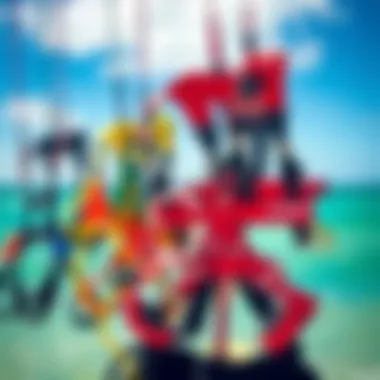
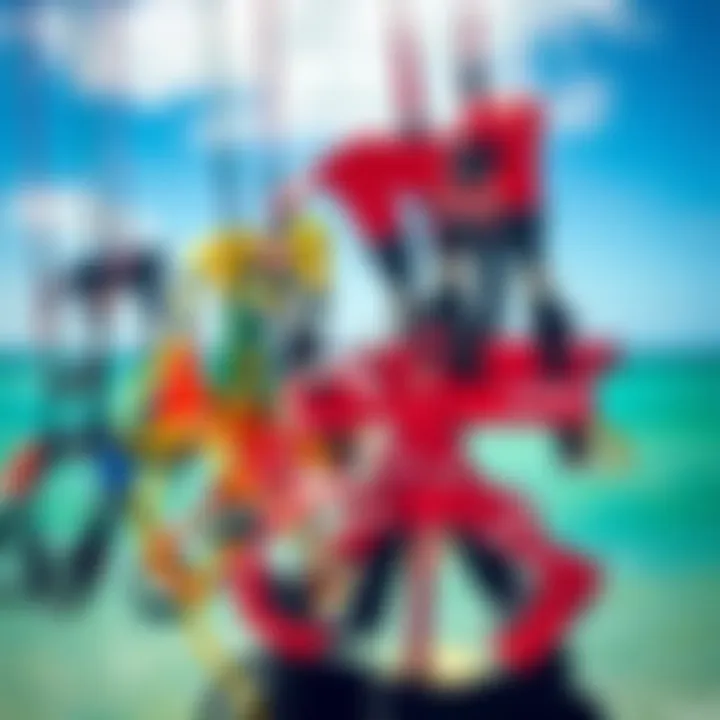
Intro
Kiteboarding harnesses often go unnoticed in the big picture of the sport, but they play a crucial role in a rider's overall performance and comfort. Not all harnesses are created equal, and understanding their intricacies can significantly enhance one’s kiteboarding experience. Each type of harness, whether it be waist, seat, or even a hybrid design, has its unique advantages that can cater to different riding styles and preferences.
Choosing the right harness is not just about comfort; it's about optimizing your performance on the water. The right fit can mean the difference between a full day of fun and an exhausting battle against discomfort. This guide aims to explore various harness types, materials, and their impact on the kiteboarder's journey.
Moreover, regular maintenance of these harnesses often gets overlooked, yet it's key to ensuring longevity and safety. Understanding common issues can help prevent accidents that otherwise would spoil a thrilling ride. From beginners who have just dipped their toes into the world of kiteboarding to seasoned enthusiasts looking to refine their setup, this guide aspires to enrich each reader’s knowledge base.
By the end of the discourse, readers should walk away with a thorough understanding of how to pick the right harness, maintain it, and stay informed about industry innovations that make kiteboarding even more enjoyable. Let’s dive deeper into the fundamental gear essential for every kiteboarder.
Foreword to Kiteboarding Harnesses
Kiteboarding is more than just a sport; it's a thrilling dance with the wind and water. Central to this exhilarating experience is the kiteboarding harness, an essential piece of equipment that not only secures the rider but also significantly influences performance and comfort. Understanding various harness options can enhance one’s experience on the water while ensuring safety and efficiency.
Importance of the Right Harness
Choosing the right harness is akin to a musician finding their best instrument. It directly affects the way a rider interacts with their kite and the stability of their movements. A well-fitted harness distributes the forces from the kite evenly across the body, preventing fatigue and discomfort during extended sessions. On the flip side, a poorly fitting harness can lead to sore backs, chafing, and even injuries, effectively cutting a session short.
One should consider several factors when selecting a harness:
- Fit: A harness that sits correctly and doesn’t ride up or dig in is crucial for prolonged use.
- Style of Riding: Different styles, whether freestyle, wave, or race, demand various support and functionality from a harness.
- Personal Comfort: Each rider might have their preference for padding, support, and materials used, which significantly influences overall enjoyment.
The choice of harness can make or break an outing, which makes understanding the intricacies between options invaluable for potential kiteboarders.
Overview of Harness Types
Harnesses come in various shapes and sizes, each designed to suit distinct riding styles and individual preferences. Here's a snapshot of the primary types:
- Seat Harness: This type offers the most lower-back support, suitable for riders who need extra stability. It sits low on the waist and is connected lower on the board, giving the rider a sense of being locked in.
- Waist Harness: As one of the most popular styles, the waist harness provides freedom of movement and is ideal for freestyle riders. It sits higher on the waist, allowing for more torso movement, which is essential for tricks.
- Hybrid Harness: A blend of seat and waist harness features, hybrids cater to those who want the best of both worlds. They provide good support while allowing significant mobility, ideal for varied riding styles.
Understanding these key harness types is crucial since selecting the right one can elevate the kiteboarding experience, making each ride thrilling and enjoyable.
"The right harness feels like second skin; it becomes part of the rider's kiteboarding journey."
Harnesses serve as a vital link between you and the kite, and knowing which type aligns with your riding style can lead to greater success on the water. For more information, visit Wikipedia or check out Reddit for community insights.
Types of Kiteboarding Harnesses
Understanding the different types of kiteboarding harnesses is essential for riders who wish to enhance their performance on the water. Each type of harness is designed with specific riding styles and preferences in mind, offering unique benefits and considerations. Selecting the right harness directly affects comfort and control, making this section critical for ensuring that riders get the most out of their kiteboarding experiences.
Seat Harness
The seat harness is often favored by beginners and those who prefer a more secure fit. This harness sits low on the hips and wraps around the thighs, distributing pressure more evenly across the body. One of the major advantages of a seat harness is its ability to provide excellent back support. Because of this design, riders can maintain a more upright position while kiting, reducing strain on the lower back.
Moreover, the seat harness minimizes the chance of pulling out due to strong kite power, which can be particularly helpful for those still mastering their technique. However, riders should be aware that while seat harnesses offer great support, they may restrict some leg movements, which could affect jumping and tricks. This limitation might not be ideal for advanced riders looking to perform aerial maneuvers.
"Choosing a seat harness can be a game-changer for someone just starting out; it helps them feel more connected and in control on the water."
Waist Harness
Waist harnesses present a popular option that many advanced kiteboarders tend to gravitate toward. Positioned higher up on the body, these harnesses offer mobility and greater freedom of leg movement, making them more suitable for jumps and tricks. The design allows for a more dynamic riding style, which can be crucial for those looking to push their limits.


These harnesses are often equipped with a spreader bar and come in different styles, including those with a low or high back. A key benefit of the waist harness lies in its ability to allow the rider to harness the kite's pull more efficiently. However, it is worthwhile to note that the lack of thigh support compared to a seat harness may mean that riders need to work a bit harder to maintain balance, especially in heavier winds.
Hybrid Harness
The hybrid harness aims to take the best of both the seat and waist designs, providing versatility for riders with mixed styles or those who wish to explore various kiteboarding techniques. This harness combines elements of both styles, often incorporating the leg straps of a seat harness with the comfort and flexibility of a waist harness.
This design allows for enhanced movement while still offering enough support, making the hybrid harness a compelling choice for those who engage in varied riding conditions. Many experienced riders appreciate this type when they’re switching between different techniques or when they’re kiteboarding in conditions that require quick adaptability. However, the hybrid harness may also come with its own set of trade-offs, as some riders might find the fit to be a bit loose in some scenarios, impacting overall control.
Material Composition and Comfort
When we talk about kiteboarding harnesses, the material composition and comfort aspects are vital. A harness isn't just a piece of gear; it's your lifeline while soaring over waves or gliding through the breeze. The right materials can make or break your experience, impacting both performance and safety.
Nylon vs. Polyester
At the heart of harness design, the choice between nylon and polyester is significant. These two materials have their own strengths and certain weaknesses, which relate directly to how they handle the rigors of kiteboarding.
Nylon is often recognized for its durability and elasticity. This material resists wear and tear better than most, making it a preferred choice for many kiteboarders. It has a certain stretch to it, giving you a bit of give when you’re performing jumps or aerial maneuvers. However, this flexibility can mean it absorbs more water, which ultimately can affect its drying time and weight when wet.
On the other hand, polyester is favored for its resistance to fading and UV damage. It tends to be a bit stiffer than nylon, providing solid support without as much stretch. While it may not offer that same forgiving feel during intense maneuvers, it dries quicker and retains its form better after repeated use. Ultimately, the choice between nylon and polyester depends on your personal preferences and riding style. Some riders may find that a hybrid approach works best, blending the characteristics of both materials in their harness.
Foam Padding and Support
Comfort in a kiteboarding harness is heavily dictated by the foam padding and support its design incorporates. The padding serves two primary functions: it cushions the impact during rides and distributes pressure evenly across the body. Without proper padding, the harness can dig into your body, leading to discomfort and frustration.
Different types of foam can be used in harnesses, each offering various levels of support. For instance, high-density foam provides exceptional support but can feel stiff initially. Conversely, softer foam may mold to your body quicker but may not give you the same long-term support during extended sessions. Finding a balance is crucial.
Additionally, pressure points are a serious concern. Well-designed harnesses ensure that the padding is strategically placed—where the body naturally experiences strain. Riders should look for harnesses with adjustable padding or customizable support features. These options can help mitigate discomfort, enhancing both performance and enjoyment during rides.
"A harness that feels like a second skin gives you the confidence to push your limits and enjoy every thrilling moment on the water."
For further exploration on materials in sports gear, sites like Wikipedia or Britannica can offer deeper insights.
Choosing the Right Harness for Your Style
Selecting the appropriate kiteboarding harness is akin to finding the right pair of shoes for a long day on your feet—it can make all the difference between comfort and agony on the water. The relevance of harness selection lies not just in comfort but also in how it aligns with your unique riding style, skill level, and personal preferences. Your harness acts as the interface between you and your kite; hence, its significance cannot be overstated.
Harnesses vary greatly in design and purpose. Certain styles cater towards freestylers looking for high mobility, while others might benefit wave riders who require stability and support. Beyond performance, it's essential for enthusiasts to consider their body type and how the harness fits since this can significantly influence both comfort and control during sessions. Thus, making an informed choice involves understanding your own needs versus what each harness offers.
Riding Styles and Their Requirements
Each riding style in kiteboarding comes with its own set of demands. Understanding these requirements is crucial when selecting a harness. Here's a closer look at how various styles dictate certain harness features:
- Freestyle Riding: This style, focused on tricks and jumps, necessitates a harness that allows for maximum freedom of movement. A waist or hybrid harness is favored here, as it provides flexibility while still offering a secure fit. Without the right harness, pulling off advanced moves can become a daunting challenge.
- Wave Riding: For kitesurfers riding waves, stability is paramount. A seat harness can offer the support needed to ride through chop and gusty winds without compromising balance. Many wave riders also prefer harnesses that minimize motion restriction, helping them to pivot and navigate the swell.
- Course Racing: In this high-speed discipline, a snug-fitting harness is crucial for maintaining control during rapid maneuvers. Many racers utilize waist harnesses due to the secure and aerodynamic fit, minimizing drag while maximizing efficiency.
- Big Air: If you're chasing adrenaline with massive jumps, choose a harness that distributes load evenly across your body. A solid waist or hybrid design is key here, along with sturdy materials that can handle the strains of high-impact landings.
Ultimately, the harness you choose should complement your style and allow you to ride with confidence, letting you focus on the adventure rather than equipment concerns.
Sizing and Fit Considerations
When it comes to kiteboarding harnesses, one size does not fit all. Ensuring you have a properly sized harness is crucial, as not only does it affect performance, but it also significantly impacts your comfort on the water. Here’s how to nail down sizing and fit:
- Measure Your Waist: Use a measuring tape to get an accurate waist measurement, ideally where the harness will sit. This measurement is essential as different manufacturers may have varying sizing paradigms.
- Consider Your Body Shape: Everyone's body is unique. Some folks might have a wider waist while others have a narrower build. Many brands design harnesses that cater specifically to different body shapes, ensuring there’s something out there for almost everyone.
- Try Before You Buy: If possible, try various harnesses in-store. Walk around and simulate kitesurfing motions to assess how it feels. It’s one thing to wear it for a few minutes; it’s another to see how well it holds up under dynamic movement.
- Check Adjustability: Adjustable features in a harness can enhance its fit, especially if your body shape changes over time. Look for harnesses with adjustable straps or a quick-release system.
- Pay Attention to Comfort: Harnesses with adequate padding and ergonomic design can make lengthy sessions much more pleasant. Test the harness while secured to a bar, as this can often reveal pressure points or areas that might lead to discomfort later.
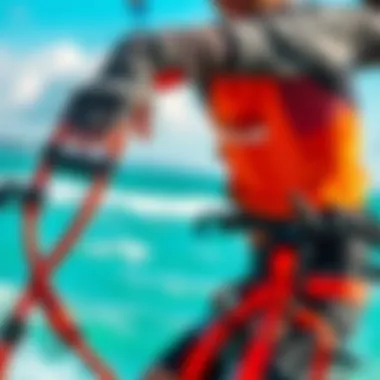
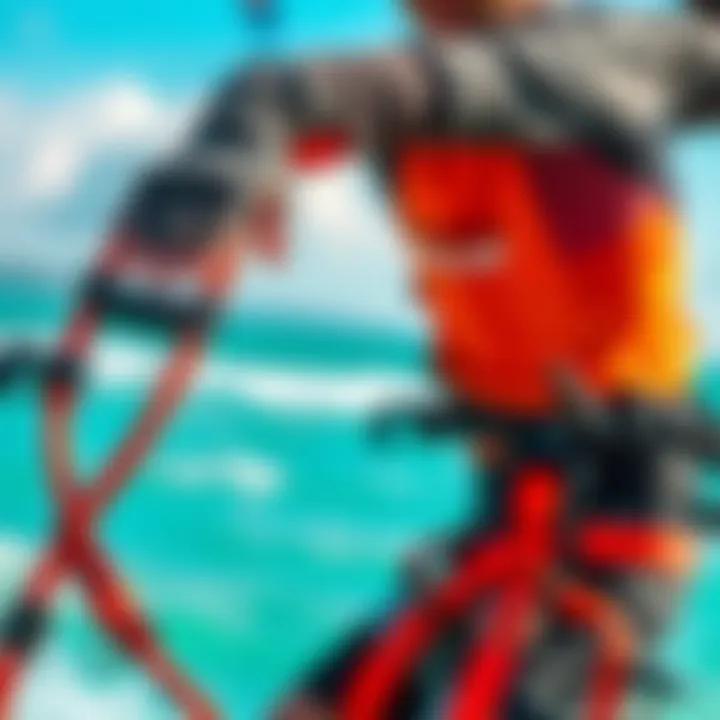
Harness Adjustments and Setup
Getting the harness adjustment right is a game-changer when kiteboarding. It can make the difference between a thrilling ride and a miserable experience. Proper adjustment ensures that the harness fits snugly on your body without cutting into your skin or restricting movement. This enables better control and harnesses the full potential of your kite. If it’s too loose, you’ll find yourself struggling against the force of the kite, and if it’s too tight, it can cause unwanted distractions during a ride.
Various factors play into how harnesses should be adjusted—rider weight, comfort levels, and riding style are just a few to consider. When setting up your harness, always ensure it’s right for you; otherwise, it might lead to performance issues. It's like the Goldilocks principle— not too tight, not too loose, just right.
Proper Adjustment Techniques
Making adjustments can seem daunting, but it isn’t rocket science. Start by strapping your harness on while standing up, which often results in a more accurate fit compared to sitting down. Once it’s on, you want to check a few key points:
- Position: Ensure the harness sits directly above your hips for optimal support.
- Tightness: When pulling on the straps, aim for a snug fit. You should be able to slide a finger underneath, but not multiple fingers.
- Shoulder Straps: If applicable, ensure they sit comfortably on your shoulders without digging in or sliding off.
Adjustments can also vary by brand. For instance, North Kiteboarding’s harnesses usually have a different adjustment mechanism compared to those from Mystic. Always check the manufacturer’s guidelines, just to be on the safe side. Listen to your body; discomfort is a clear sign something isn’t right.
Connection to the Kite System
The connection between your harness and the kite system is vital. It serves as the bridge that transfers the momentum from the kite to your body. The harness should connect to the kite line systems via a loop or spreader bar, depending on its design type. This connection should be smooth and seamless; any hiccup might lead to a disruption in your ride.
Before taking off, give everything a thorough inspection. Here are some pointers:
- Safety Leash Attachment: Make sure it’s securely fastened. This can prevent accidents if the kite drifts away from you.
- Clean Connection: Check for any dirt or debris that may affect the functionality. A clean hook ensures your lines stay aligned and can deal with load effectively.
In kiteboarding, the connection to the kite is as crucial as the harness itself. Without it, you might as well be sitting on a park bench rather than gliding over waves. With the right harness adjustments and connection setup, you set the stage for an exhilarating ride.
"The right harness adjustments not only enhance your comfort but also boost your ride performance tremendously."
For further guidance and manufacturer recommendations, consider checking out resources like Reddit Kiteboarding Community or materials from Kiteboarding.com.
Naturally, continuous practice with adjustments leads to improved performance. Like any skill, it takes time, but the benefits are well worth it when you feel the wind beneath your feet and the kite at your command.
Safety Considerations
Kiteboarding can be an exhilarating sport, but it comes with its own set of risks. When it comes to harnesses, ensuring optimal safety is paramount. Understanding the implications of harness use and recognizing the associated hazards allows you to enjoy the thrill of kiteboarding while minimizing the risk of injury. Here's why safety considerations must be at the forefront of every kiteboarder's mind.
Common Hazards with Harness Use
When using a harness, there are various hazards a rider might encounter. Typcially, the most significant ones include:
- Improper Fit: A harness that's either too tight or loose can lead to discomfort or even accidents. A tight harness can restrict blood flow, while a loose one might not provide adequate support, increasing the risk of a fall.
- Connection Failures: Issues with the connection points between the harness and the kite can lead to spontaneous disconnections, which could result in severe incidents on the water. It’s crucial to ensure that all connections are secure.
- Tangled Lines: A tangled harness line can be a recipe for disaster. If lines snag on objects or even on the kite itself, they can lead to loss of control and potential accidents.
- Sweat and Wear: Over time, harnesses can wear down due to saltwater, wind, and sun exposure. Regular use without maintenance can cause weakening of straps or buckles, leading to a higher risk of failure.
- Unexpected Releases: Release systems are essential for safety, but they can malfunction or be inadvertently engaged. It's wise to familiarize oneself with the release mechanism to avoid mishaps.
It's vital for riders to be aware of these hazards and perform regular inspections of their harness and accompanying gear.
Maintenance and Inspection Tips
Regular maintenance is the backbone of kiteboarding safety. A well-maintained harness not only prolongs its lifespan but also enhances your safety on the water. Here are some tips to ensure your harness remains in top shape:
- Routine Inspections: Each time you prepare for a ride, inspect your harness for any visible signs of wear. Look for frayed straps, rusted buckles, or any parts that look out of place.
- Clean After Use: After each session, rinse the harness with fresh water to remove salt, grime, and sand. This simple step can significantly extend the life of your harness.
- Dry Properly: Ensure that your harness is dried out completely after rinsing. Storing a wet harness can lead to mold or mildew growth, which compromises the integrity of the materials.
- Check the Padding: Ensure that the foam padding is intact and not compressed or deteriorated. This padding is vital for mitigating strain on your back and sides while riding.
- Replace Worn Parts: If any part of your harness is worn out, don’t hesitate to replace it. This could mean simply replacing straps or buckles instead of overhauling the entire harness.
- Read the Manual: Manufacturers sometimes provide specific maintenance instructions that can be crucial to your safety. Make sure to refer to these guidelines.
By following these maintenance tips, kiteboarders can ensure their harness stands the test of time and any trials on the water.
Innovations in Harness Design
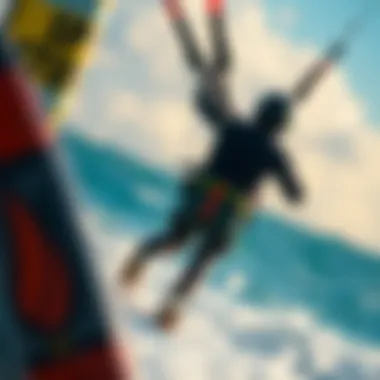
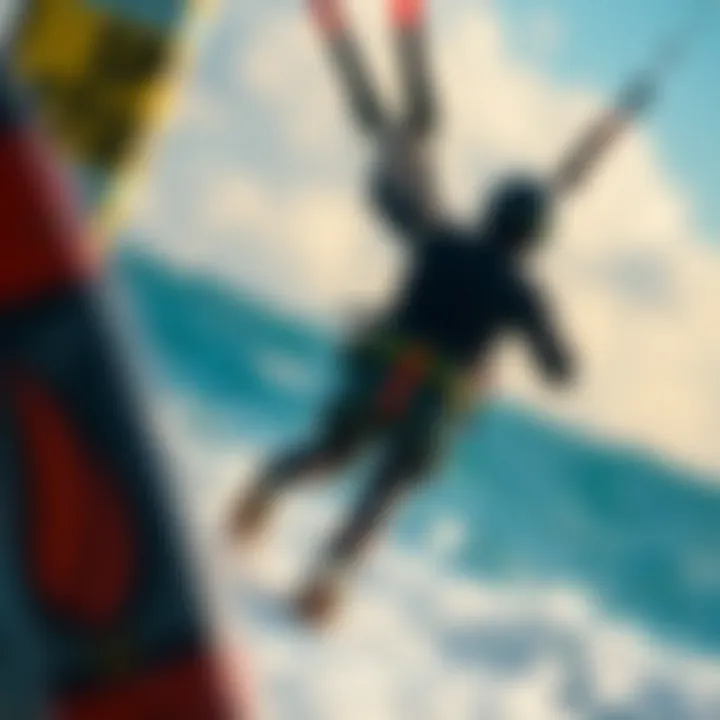
Innovations in harness design have blossomed significantly in the recent years, bringing about changes that cater to the evolving needs of kiteboarders. As kiteboarding continues to grow in popularity, manufacturers have started focusing on enhancing comfort, safety, and performance. Effectively, these innovations allow riders to enjoy a more seamless experience on the water.
Technological Advancements
The landscape of harness technology has dramatically shifted, thanks to improvements geared towards enhancing both usability and rider performance. For instance, one of the most notable advancements is the integration of adjustable leg straps, which offer a custom fit for various body types. This capability allows for easier entry and exit while providing unwavering support during rides. Another major leap is the advancement in materials, like the use of lightweight carbon fiber components that reduce the overall weight of the harness without compromising strength. This is key as kiteboarders constantly push their limits, and a lighter harness can make a significant difference in agility and performance. Lastly, manufacturers have implemented smart materials that respond to the rider's movements, providing maximum flexibility while ensuring durability.
Future Trends in Harness Development
As we look toward the horizon of harness development, several trends are emerging that aim to further refine and revolutionise the kiteboarding experience. One such trend is the personalized harness systems that utilize 3D body scanning technology. This innovation allows users to tailor their harness to their unique body shape, optimizing comfort and control. Furthermore, sustainability is becoming increasingly vital. The industry may see a shift toward biodegradable materials and eco-friendly manufacturing processes, reflecting a growing environmental consciousness among consumers. There is also a surge of interest in incorporating enhanced safety features like integrated quick-release systems and flotation aids to aid recovery in the event of a mishap. The direction of these developments highlights a commitment towards increased rider safety and a more personalized riding experience.
"With every innovation, the promise is clear: a better ride for kiteboarders everywhere."
Common Problems and Solutions
Addressing common problems with kiteboarding harnesses is crucial for maximizing performance and ensuring safety on the water. Navigating the windy waters of kiteboarding can sometimes lead to a few bumps in the road, or rather, the sea. But being prepared to tackle these issues can make your kiteboarding experience not just manageable but enjoyable. Here, we'll dig into performance issues that often arise and how to adjust your harness to get the most out of your kiteboarding sessions.
Identifying Performance Issues
Before you can address any issues, you must first pinpoint what’s going wrong. Some common performance issues with harnesses can include discomfort, lack of support, or failure to connect properly to the kite system. Sometimes, a harness might just not feel right, leading to a less enjoyable ride or even potential risk.
When you’re out on the water, stay alert for:
- Chafing or discomfort: This could indicate that your harness is too loose or too tight. If the fit isn’t correct, it may cause friction that can lead to irritations or even rash.
- Slipping or riding up: A harness that constantly slips can be more than just annoying; it can also hinder your ability to control the kite effectively.
- Lack of back support: If you feel like your back is taking a beating, your harness isn’t providing enough lumbar support, and that’s a red flag.
To visually assess your issues, stand in front of a mirror while wearing your harness.
"A quick visual check can help: Are there any pinch points? Does it fit snug but not too tense?"
Adjustments for Optimal Performance
Once you’ve identified the performance issues, it's time to make some adjustments. Getting the adjustments right can mean the difference between soaring successfully or crashing hard.
- Adjust the straps: Ensure that the straps of the harness are correctly adjusted for your body type. The lower back strap should sit snugly without pinching.
- Re-position the harness: If your harness is riding up, consider adjusting the position to sit lower on your hips. It might just be a matter of shifting it a few centimeters.
- Check the spreader bar: A common cause of slipping is an ill-fitting spreader bar. Ensure that it sits correctly and doesn’t have any wear or tear that could make it unreliable.
- Experiment with fit: Don’t hesitate to try different harnesses. If you continually feel discomfort with one, it could be a mismatch.
Taking time to tweak your setup can lead to remarkable improvements in your performance. Aligning the harness with your body might seem simple, but an ideal fit enhances your ability to maneuver more efficiently, making your kiteboarding sessions not just fun, but also less taxing.
The End
As we draw the curtain on our deep dive into kiteboarding harnesses, it’s crucial to reflect on the essence of our exploration. Harnesses are not just accessories; they are vital instruments that affect a rider’s performance, safety, and overall experience on the water. The right harness can make the difference between a seamless ride and a frustrating struggle with your equipment.
In this article, we outlined the importance of choosing a harness that aligns with your riding style, body type, and personal preferences. By understanding the differences between seat, waist, and hybrid harnesses, riders can make informed choices that enhance their performance and comfort.
Safety considerations were underscored, reminding us that proper harness use involves regular maintenance and diligent inspections. Without taking these factors into account, even the best equipment can lead to dangerous situations.
Moreover, we have taken a look into innovations that enrich harness design, which is crucial as technology evolves. Features like improved material composition and ergonomic adjustments pave the way for more enjoyable rides.
Finally, laying out solutions to common problems helps prepare every kiteboarder for challenges they may encounter along the way. Whether it’s adjusting fit for better performance or identifying wear and tear, this knowledge empowers riders to extend the life of their equipment while maximizing fun and safety on the waves.
Recap of Key Points
- Harness Selection: Picking the right type (seat, waist, or hybrid) caters to individual riding styles and preferences.
- Safety: Regular maintenance and proper adjustment are paramount for safer kiteboarding experiences.
- Materials and Comfort: Different materials such as nylon and polyester influence durability and comfort.
- Innovations: Keeping abreast of technological advancements can significantly enhance both performance and safety.
- Common Issues: Addressing performance setbacks with the right adjustments promotes optimal riding conditions.
"The right harness isn’t just about comfort; it’s about elevating your entire kiteboarding adventure into something unforgettable."
Final Thoughts on Harness Selection
Ultimately, when it comes to harness selection, the stakes are high. The choices made here carry weight, dictating not only personal comfort but also the potential for skill progression. Take the time to engage with various types of harnesses, trusting your own instincts about what feels best. Aim for a fit that provides support without restricting movement. Preferably, test out different styles before committing—what works for one person may not work for another.
In the ever-evolving landscape of kiteboarding, being attuned to the changes in harness technology can offer a competitive edge. Embrace the opportunities each ride offers, blend enjoyment with safety, and always aim for that perfect balance where you feel most at home on the water. By carefully considering every element discussed, from performance to maintenance, you too can take the plunge into an enriched kiteboarding experience.



